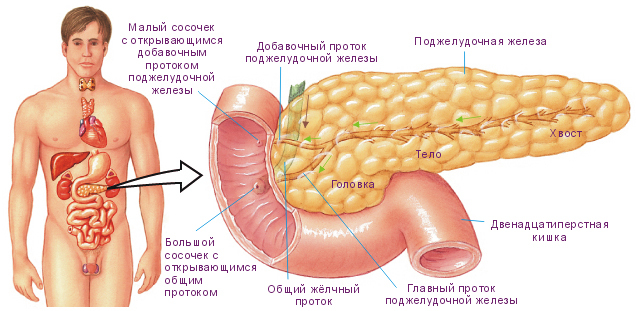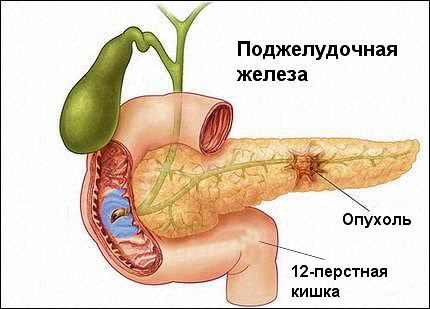Pancreas kink and deformity: the pancreas is deformed and kinked
The pancreas is an oblong organ in the abdomen. Its location is one of the main factors that ensure digestive work.
Bending of the pancreas is a serious pathology, the treatment of which should be given special attention.

Content:
- 1 RV deformation
- 2 Factors provoking the appearance of pathology
- 3 Symptoms
- 4 Pediatric deformity of the gland
-
5 Therapeutic measures
- 5.1 Diet for bending the pancreas
- 6 Useful video
RV deformation
The human body is designed so that the pancreas can periodically move. But at the same time, it is not deformed.
A slight displacement of an organ is not a pathology that leads to the manifestation of alarming symptoms.
However, the deformation of the pancreas is a problem, the appearance of which can provoke the development of serious complications.
First of all, if it is present, digestion will suffer. A person will not be able to eat food, and if he can, then the enzymes in his body will not be enough to assimilate it.
Important! A change in the structure of any internal organ indicates a pathological process in the human body.
It is a mistake to believe that the pancreas looks the same in all people. Its shape depends, first of all, on the anatomical features of a particular person.
There is a category of people in whom this organ is slightly elongated, while in others it, on the contrary, will flatten.
When a person changes position of the body, the gland can move. This is normal. If he is lying, his body is slightly lower than when standing or sitting.
Bending of the pancreas poses a serious danger to human health and life only if it leads to organ dysfunction.
In general, this pathology is not systematic. Rather, it is a temporary deviation. Before starting treatment measures, you should find out what triggered the deformation of the organ.
Factors provoking the appearance of pathology
Doctors can observe this pathology even in children. Usually, when a baby is diagnosed with such a diagnosis, his parents are very worried.
In fact, timely diagnosis will help prevent the occurrence of complications following the inflection of the pancreas.
But why does this pathology make itself felt? According to doctors, there are 3 main factors that can provoke bending of the gland.
Let's list them:
- Cyst on the body of the organ. The process of cyst formation is one of the complex physiological processes that can lead to irreversible consequences. To diagnose a cyst, you need to take a picture of the gland. On one of the parts of her body there will be a darkening - this is the cyst.
- Chronic pancreatitis. One of the most dangerous complications of chronic pancreatitis is pancreas bending. In this case, it shifts slightly upward. If the disease proceeds in an acute form, it is accompanied by the appearance of other complications, namely vomiting, nausea, severe bloating, diarrhea, and so on.
- Cancer tumor. The presence of a malignant neoplasm on the body of the gland can lead to its deformation. As the healthy cells of the organ divide, they become pathological, therefore, the lifespan not only shifts, but also changes its shape. Ultrasound examination will help to see the malignant neoplasm on the pancreas body.
Regardless of the cause of the appearance of the pathology, it is important to take timely measures to eliminate it.
However, doctors identify other factors that can affect the appearance of this problem:
- Pancreas trauma. If a person hits the stomach hard, or rather the place where the pancreas is located (left hypochondrium), there may be swelling of the organ. Due to his injury, inflammation may occur.
- Genetic predisposition. Often this "inheritance" is passed on from relatives.
- Overweight. Obese people are more likely to experience pancreatic problems. One of the preventive measures aimed at preventing their occurrence is body shaping.
- Diabetes. In this case, kinking of the pancreas makes itself felt as a complication of diabetes.
Symptoms
So, you are faced with such a problem as deformation of the pancreas. But how is this to be understood? Everything is very simple. It is enough to pay attention to the manifestation of the signs of this pathology.
Deformation of this organ, accompanied by damage to its tissue surface, is characterized by the manifestation of the following symptoms:
- Severe flatulence (bloating).
- Nausea sometimes accompanied by vomiting.
- Increased body temperature.
- Severe pain in the left hypochondrium.
- Disruption of the functioning of the gastrointestinal tract (constipation can be replaced by diarrhea and vice versa).
- Discomfort in the lumbar and scapular region.
Such a clinical picture indicates the course of a pathological process in the body. So that the situation does not get complicated, you need to resort to therapy on time.
Pediatric deformity of the gland
This pathology is diagnosed not only in adults, but also in young patients. As medical practice shows, bending of the organ in young patients in most cases is observed in acute pancreatitis.
In this case, pancreatic deformity is a complication of acute pancreatitis. Therefore, in order to get rid of such a problem, you will have to cure its root cause - that is, pancreatitis.
However, the course of this ailment is not always associated with this unpleasant disease of the gastrointestinal tract.
The trigger mechanism for the deformation of the gland can be improper nutrition. Usually, children from irresponsible parents suffer from gastritis, stomach ulcers and pancreatic deformities.
Therefore, it is very important to correctly plan the diet of your child and not give him the opportunity to harm his gastrointestinal tract with improper nutrition.
As for newborns, their pancreas is wedge-shaped. However, as the child grows, the shape of the organ changes.
It becomes more elongated, and bends form on its surface.
Important! If the suspicious form of the pancreas is not accompanied by the manifestation of alarming symptoms, then there should be no reason for panic, since the organ will acquire standard parameters with age.
To normalize, 3 main measures should be taken:
- Observe preventive measures for diseases of the gastrointestinal tract and pancreas.
- Monitor your child's nutrition.
- Control the stability of its digestion.
With a systematic manifestation of symptoms, indicating RV dysfunction, be sure to examine the baby with a pediatrician.
Therapeutic measures
First of all, the treatment of this pathology should be based on the reason for its appearance.
For example, if an exacerbation of pancreatitis became the factor that provoked dysfunction and bending of the gland, then therapy should be based on stopping the symptoms of this ailment.
The bending of the gland will be treated by different doctors, depending on the symptoms that accompany it. For example, in the presence of inflammation of the tissue surface of an organ - a therapist.
But if an ultrasound scan showed a suspicious darkening, there is a high probability of the presence of a neoplasm on the body of an organ.
Then the patient will need an oncologist's consultation. In the most severe cases, the pathology becomes malignant.
Then you cannot do without the help of a surgeon. However, surgery is a last resort. Usually, doctors do everything possible so that the patient does not have to go to the surgeon's table.
The normal position of the organ can be stabilized by taking appropriate medication.
Do not forget that when bending the pancreas, only a doctor can prescribe any medications.
So, in the presence of this pathology, the patient is prescribed medications of the following groups:
- Pain relievers and antispasmodics.
- Antienzyme drugs.
- Antibacterial.
- Anti-inflammatory.
Of course, if the tissue surface of the gland is not inflamed, then there is no need to take anti-inflammatory drugs.
Doctors advise to follow the drinking regimen. Dysfunction of this organ can lead to dehydration of the body, therefore, both children and adults need to drink as much mineral water as possible.
Diet for bending the pancreas
Without observing the rules of a therapeutic diet, it is impossible to normalize the work of the pancreas. However, one of its main tasks is the restoration of enzymatic activity.
It is also important that the patient does not overeat, because excessive stress on the gastrointestinal tract in the presence of deformation of the gland is contraindicated.
Advice! Sit upright when eating food. You should not draw your legs to your stomach, because this position makes it difficult for the digestion process.
Basic rules of a therapeutic diet:
- Don't overeat. The patient's nutrition should be measured. It is recommended to sit at the table 4 to 7 times a day.
- To prevent digestive overload, chew food well before swallowing. With dysfunction of the pancreas in the feces, pieces of poorly digested food can be found.
- Avoid eating foods rich in carbohydrates. It is difficult for the stomach to digest. It will take a long time to digest it.
- Choose protein foods like boiled meat and eggs.
- Eliminate smoked, spicy, and fried foods from your diet. It is difficult for the digestive tract to digest.
- Fatty foods should be completely excluded from the diet. If a patient who has been diagnosed with a bend in the gland eats fried pork or fatty sour cream, he will get worse.
What foods and drinks are excluded from the patient's diet?
- Alcohol.
- Corn.
- Raw vegetables and fruits.
- Ice cream.
- Fried fish and meat products.
- Pasta.
- Beans.
- Sour berries.
Moreover, during treatment, it is highly discouraged to eat foods that are on the list of "harmful".
We are talking about crackers, chips, snacks and so on. In conclusion, I would like to say a few words about the need to comply with preventive measures.
At the first signs of deformity of the gland, you should not postpone the trip to the hospital. In this case, an ultrasound examination will be sufficient to assess the condition of the organ.
If the prostate gland is indeed bent, follow your doctor's instructions for therapy.



